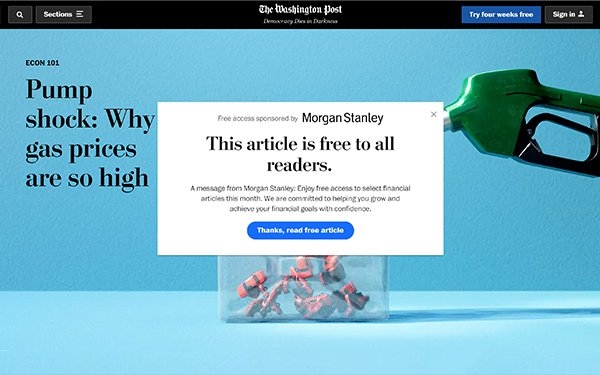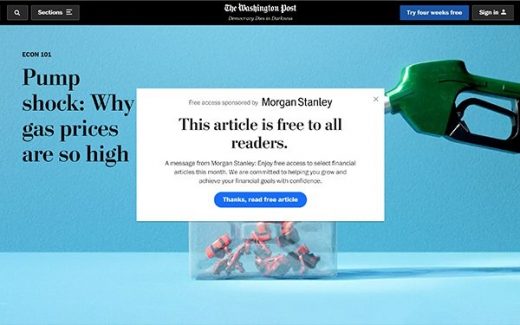Morgan Stanley Sponsors Washington Post Content, Takes Down Paywall
Morgan Stanley Sponsors Washington Post Content, Takes Down Paywall

The Washington Post on Monday will officially introduce a series of articles with visual animated content in an effort to change economic journalism.
The series aims to demystify financial trends, such as inflation and rising gas prices. Econ 101: Navigating the Economywill include other topics in the series scheduled throughout the year. The first piece on inflation published in March. The piece on gas prices followed in June.
Morgan Stanley sponsored the content series, unlocking the paywall and engaging readers who are curious about and interested in the economy. It allows anyone to read and share the information in the articles.
“This is the first time we have done a sponsorship like this, where we removed the pay wall from access to the data and information, broadening the opportunity for all to read, not just those with subscriptions,” said Alice Milligan, CMO at Morgan Stanley.
The sponsorship fits into a broader strategy for the company, educating people, giving them access to information for free.
Milligan hopes other companies will step in to sponsor content, “democratizing information,” something Morgan Stanley will likely do again because it demonstrates what the brand represents.
Andre Rucker created the visual animation running with the article Pump shock: Why gas prices are so high. Anna Hrachovec knitted the characters for the visual animation running with the article Inflation explained: How prices took off.
The series will be promoted on Twitter and Instagram, as well as in its newsletters.
The financial firm also has a podcast titled Thoughts on the Market.
Morgan Stanley marketers are measuring engagement from the articles posted during the past few weeks, data shows an increase in traffic to its site based on the sponsored content, but not solely through The Washington Post site. Milligan said that although it is still very early in the analysis, indicators point to success of the company’s commitment to enable greater access to education, resources and tools that grow and preserve wealth, and encourage financial empowerment.
The Washington Post also has been measuring the content, and found that search engines have led nearly half the readers to the gas prices article. It’s about making content discoverable anywhere, said Washington Post Deputy Business Editor Damian Paletta.
“We’re trying to reimagine economic journalism,” Paletta said. “Hundreds of thousands of people are googling why gas prices are so high.”
Editorial teamed up with the design team to take on issues like inflation to present it in a visual way. Discussions for this series began around January or February. The team brainstormed each Friday afternoon to look at different artists’ work and bring the stories to life.
“Working with the design and the economic teams, we started with the idea of the red balloon,” Paletta said. “We all know a balloon inflates.”
The red balloon representing the story of inflation came first, but the topic of rising gas prices began in early March, long before the United States experienced rapid increases.
“When I was a cub reporter, I always thought a lot of people saw economics journalism as broccoli,” Paletta said. “It’s something on the plate you have to eat, but you really want to eat the dessert instead. If we can make it visual — sugarcoat it — people don’t realize they’re consuming more vegetables.”
(21)


